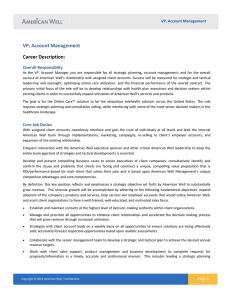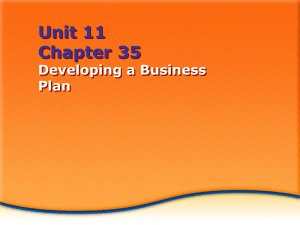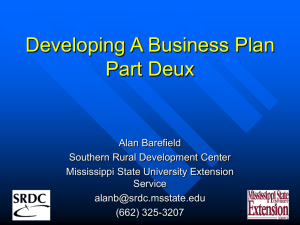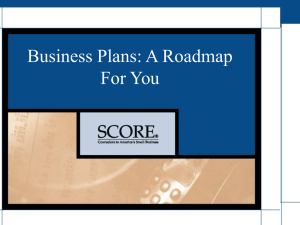2.09 Describe entrepreneurial planning considerations
advertisement
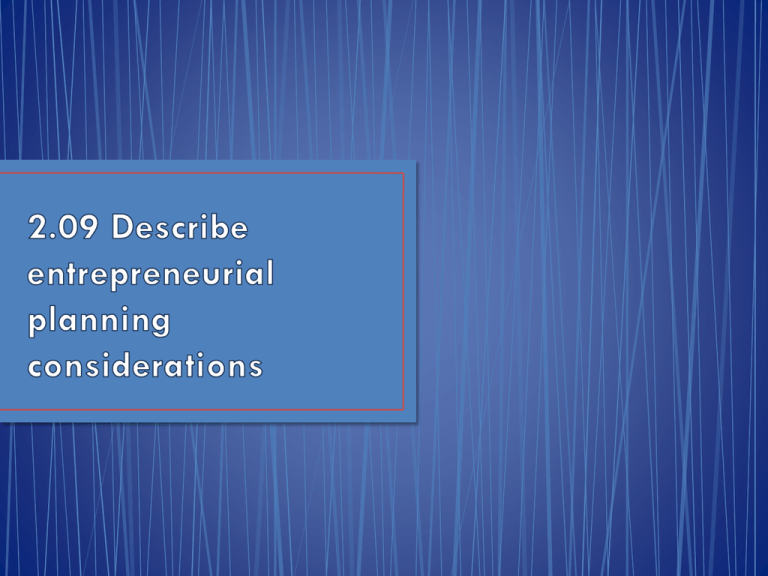
http://www.dukeven.com/Home • Entrepreneurs discover an entrepreneurial opportunity when they find a compelling solution to an unsolved problem or unsatisfied need. The first step in an entrepreneurial venture is to identify a real opportunity. Second step is to create a plan to address that opportunity. Third step is to execute that plan. • Business planning is the process of setting goals, explaining the objectives and then mapping out a document to achieve these goals and objectives. • Effective business planning is critical to long-term success and the ability to raise capital and grow successfully. Business Planning, cont., • Effective business planning requires a considerable amount of time • Effective entrepreneurial planning consists of: • Strategic planning • Setting and enforcement of goals • Road map of strategies on “what” the business intends to do to meet the goals and objectives • Tactical planning • Contains the details of executing your strategies • Describe “how” you plan to meet the objectives • Strategy is the thinking process required to plan a change, course of action, or organization. • Strategic planning defines, or outlines, the desired goals and why you should go about achieving them. • The strategic planning phase involves business thinkers (namely– the small business owner) determining why, and in a global sense what, you will achieve in your stated goals. Strategic planning • When doing strategic planning, you need to determine, specifically, what outcome you want to achieve (These are your Objectives) and how you will measure the results. • Tactical planning requires the understanding and deciphering of the strategic goals; then identifying the courses of action needed to achieve those strategic objectives. • Tactical planning is developed by those who deal with getting the work done, day by day. • The main question for them is: “How can the strategic goals be accomplished within the designated limits of resources and authority?” • Tactical planning is actions taken day-to-day, whose results will move the company forward to achieve the objectives in the strategic plan. Business Plan A proposal that describes a new business. It is presented to potential investors and lenders. • A well-written Business Plan lays out the best growth path & strategy, as well as the rationale for the selection of the strategy over other alternatives. Business Plan cont., • A Business Plan is the explanation of: • why the plan for building the company makes sense, •what resources it will need to implement the vision, • who the team will be that will have the skills and leadership to execute the vision, and what path they will follow to get there. The components of a business plan •Executive summary •Product/service plan •Management team plan •Industry/market analysis •Operational plan •Organizational plan •Marketing plan •Financial plan •Growth plan • Brief recounting (summarizing) of the key points contained in a business plan. • Investors & lenders rely on this to decide if the concept interests them • Should be no longer than two pages. • Include the most important information from each section of the plan. • Written last • Mission Statement • Presentation of the product or service you’re offering. • Nature of your business • Unique features of your product/service • Any possible spin-offs • Additional products or services that might be offered once the business is established • Present entrepreneur’s qualifications & those of any partners involved in the business venture. • Analyze expertise you’re missing & how you will solve that problem • Describe any advisory board members/Board of Directors that will assist in getting the business started • Convince the reader that an explosive market opportunity exists • Presents research into the industry & market • Analyze customers, competition, & industry • Information about the prospective geographic location, economic, & demographic data • Includes all processes involved in producing and/or delivering the product or service to the customer. • Status of product development • Equipment, inventory, production • Time & money needed • Distribution plans (Channels of Distribution) • Direct channel – delivery directly to the customer • Indirect channel – product sold to someone before it reaches the customer (wholesaler) • People aspects of the business. Includes: •Management philosophy •Legal form of the company •Key management personnel •Key employment policies • How your company makes its customers aware of its products or services • Market segment • Pricing policy • Company image • Marketing strategies • Promotional plan • Marketing budget • Presents the forecasts for the future of the business • Includes assumptions made when calculating your forecast figures • Usually in the form of financial statements • Looks at how the business will expand in the future. •Investors & lenders look to see if the business has the potential & the plans to grow over its life • http://www.entrepreneurship.org/en/resource-center/businessplanning-building-an-effective-business-model.aspx • http://www.dukeven.com/Home/Planning • http://www.scribd.com/doc/3911336/EntrepreneurialPlanning-and-Goal-Setting • http://smallbizlink.monster.com/training/articles/855-strategicand-tactical-planning-understanding-the-difference


